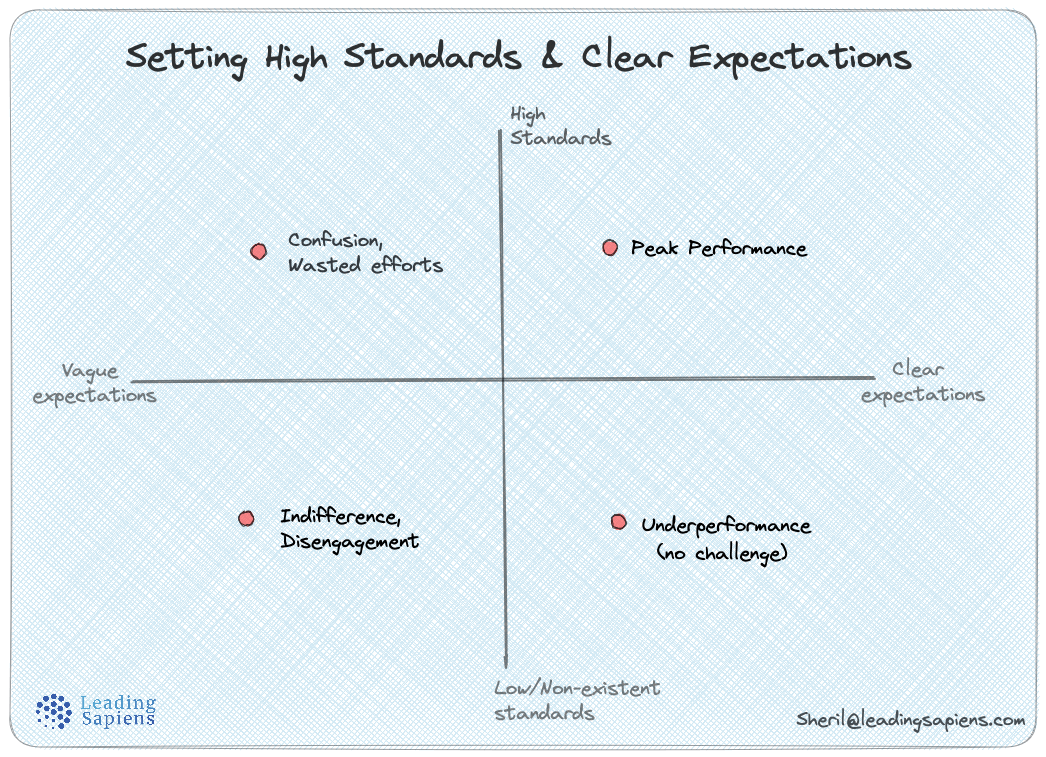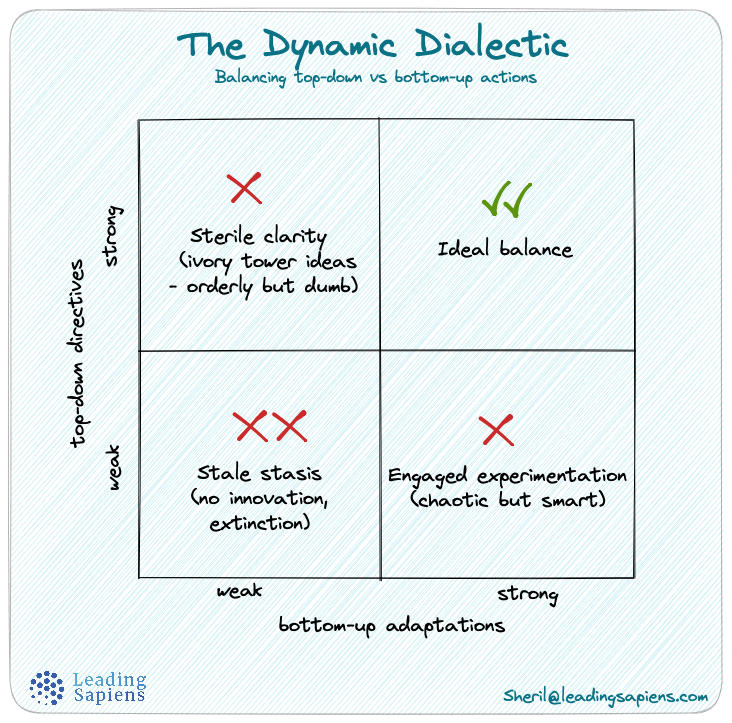OKRs and strategy are considered key responsibilities of leadership. But more often than not, managers end up doing more harm than good.
Here are four common ways they screw it up:
#1. Expecting OKRs and people to "do their job".
#2. "Big picture only" managers.
#3. Confusing goals with objectives.
#4. Forgetting mundane execution and their own role in it.
I was once part of a high performing sales team for a long cycle, technical product — we had broken records for five consecutive quarters in a tepid market. But that's when "leadership" got greedy. Whether out of plain malice or just stupidity, they tripled our targets overnight.
But increasing targets wasn't really the core issue. High performers thrive on challenges, and setting high standards is a proven method to push performance. The real problem was that leadership's involvement ended with setting those impossibly high targets.
Increasing performance targets by doing it in a vacuum, without giving much thought to, let alone participate in, how to get there and what it looks like is a recipe for disengagement and disaster. Which is exactly what happened to that team - almost all members were gone over a span of two years.
This kind of dysfunctional behavior is common if not widespread. Organizations often set ambitious targets without changing any of the underlying structures or contributing factors. Like mice responding to sugar in classic behaviorism, are people simply supposed to automatically respond positively to high goals?
Turns out, there are some common patterns how managers screw up the OKR and strategy process, and in the process inflicting damage instead of actually helping. Sometimes it's because of ingrained bad habits, while at other times it's just plain ignorance.
Mistake#1 Expecting OKRs and people to "do their job"
Too many managers think their job is to design the perfect OKR or come up with the best strategy. Designing OKRs is considered as setting "strategic direction" and "leadership", whereas followup and execution reeks of "managing". The underlying assumption? Given the "right" OKRs and strategy, you shouldn't have to manage.
Of course no one puts it that way, but that's the implied message when you have a month long OKR and strategy process, and then simply ask for quarterly updates and wondering why it's not working after all. They expect the process and the people to do "get the job done", but this is mistaken.
In his book Empowered, Marty Cagan highlights three primary reasons why the OKR process doesn't yield results for most companies. Other than structural issues, what's the biggest culprit? Leader attitudes and their lack of involvement beyond setting the OKRs.
And finally, and really the root of the problem, is that in the vast majority of companies I see that are struggling to get any value out of OKRs, the role of leadership is largely missing in action.
They literally think that the idea is to let teams identify a set of objectives, and then let them pursue those objectives, and we'll see where we are at the end of the quarter.
They think that empowered product teams, and this technique especially, is about less management. But as I've tried to emphasize throughout this book, it's really about better management.
It is really any wonder why so many companies get so little value from this technique?
...Leaders need to step up and do their part to turn product strategy into action
— Mary Cagan, Chris Jones in Empowered
So why are leaders "missing in action" and not doing their part? After all, isn't that their job? There are two primary contributors to this malaise. One is thinking that execution and "figuring it out" is not their job.
Mistake #2 "Big picture only" managers
Consider this famous line by management guru Warren Bennis:
Managers are people who do things right and leaders are people who do the right thing.
In many training programs, it's fashionable to draw a clear line between managing and leading. Leadership gets put on a lofty pedestal while managing gets a secondary role, almost as a necessary evil. Too many managers get hung up on this distinction.
Stanford professor Bob Sutton puts it this way:
There is a difference between management and leadership, but focusing on it is dangerous....because it distorts how too many bosses—at all levels—view and do their work. It encourages bosses to see generating big and vague ideas as the important part of their jobs—and to treat implementation, or pesky details of any kind, as mere “management work” best done by “the little people.”
Even if left unsaid, this distinction reflects how too many bosses think and act. They use it to avoid learning about people they lead, technologies their companies use, customers they serve, and numerous other crucial little things. Among the CEOs, Brad Smith of Intuit...reacted most strongly to these arguments. He explained they struck a nerve because of his experience with developing new managers: the best are obsessed with learning details about every aspect of the business; the worst—the least promising and most arrogant—treat such nuances as being somehow beneath them.
“Big picture only” bosses often make decisions without understanding constraints that affect the cost and time required to implement them. They are especially prone to suffer from the smart-talk trap ...because actually doing things and making sure things get done are chores for little people, not top dogs, A-players, or high potentials like them.
I am all for big ideas, visions, and dreams. But the best bosses do more than think big thoughts. They have a deep understanding of their industries, organizations, and teams, the people they lead, as well as other mundane things.
— Robert Sutton in Good Boss Bad Boss
Strategies and objectives detached from the realities of execution is an all too common phenomenon. There's a reason why HP during it's heyday was known for pushing its managers to regularly do MBWA - managing by wandering around. Only by engaging with the mundane details does strategy often emerge.
"Big picture only" managers also end up overly reliant on purely top down approaches instead of balancing it with feedback from the frontlines.
Mistake #3 Confusing goals with objectives
Ambitious goals are meant to rally everyone, aligning the team behind a purpose, and getting everyone focused in order to achieve a common target. Except people are not stupid. If leaders set ambitious targets without a path to get there, no amount of external motivation or push is going to work.
The fundamental mistake is not understanding the difference between goals, and the strategy and objectives to get there. As basic as that sounds it's surprising how many folks don't get this basic distinction.
Richard Rumelt highlights this common mistake in Good Strategy/Bad Strategy:
...it is helpful to use the word “goal” to express overall values and desires and to use the word “objective” to denote specific operational targets. Thus, the United States may have “goals” of freedom, justice, peace, security, and happiness. It is strategy which transforms these vague overall goals into a coherent set of actionable objectives—defeat the Taliban and rebuild a decaying infrastructure. A leader’s most important job is creating and constantly adjusting this strategic bridge between goals and objectives.
Rumelt highlights how even when this distinction is understood, often objectives are just plain bad, what he calls "dog's dinner objectives" and "blue sky objectives":
Good strategy works by focusing energy and resources on one, or a very few, pivotal objectives whose accomplishment will lead to a cascade of favorable outcomes. One form of bad strategic objectives occurs when there is a scrambled mess of things to accomplish—a “dog’s dinner” of strategic objectives.
A long list of “things to do,” often mislabeled as “strategies” or “objectives,” is not a strategy. It is just a list of things to do. Such lists usually grow out of planning meetings in which a wide variety of stakeholders make suggestions as to things they would like to see done. Rather than focus on a few important items, the group sweeps the whole day’s collection into the “strategic plan.” Then, in recognition that it is a dog’s dinner, the label “long-term” is added so that none of them need be done today.
The second form of bad strategic objectives is one that is “blue sky.” A good strategy defines a critical challenge. What is more, it builds a bridge between that challenge and action, between desire and immediate objectives that lie within grasp. Thus, the objectives a good strategy sets should stand a good chance of being accomplished, given existing resources and competence. ... By contrast, a blue-sky objective is usually a simple restatement of the desired state of affairs or of the challenge. It skips over the annoying fact that no one has a clue as to how to get there.
A leader may successfully identify the key challenge and propose an overall approach to dealing with the challenge. But if the consequent strategic objectives are blue sky, not much has been achieved. The purpose of good strategy is to offer a potentially achievable way of surmounting a key challenge. If the leader’s strategic objectives are just as difficult to accomplish as the original challenge, there has been little value added by the strategy.
– Richard Rumelt in Good Strategy Bad Strategy
This brings us to the fourth mistake. Strategy is glamorous, while the mundane realities of execution not so much.
Mistake #4 Forgetting mundane execution and their own role in it
The reality of any strategy is that most of the time everyone knows what needs to be done. It's not necessarily the brilliance of the strategy per se, but rather how much commitment we have and how consistently we go about executing the mundane basics on an everyday basis.
David Maister uses the analogy of the fat smoker who knows what needs done but never gets around to it:
We know what to do, we know why we should do it, and we know how to do it. Yet most businesses and individuals don't do what's good for them.
The problem is that many change efforts are based on the assumption that all you have to do is explain to people that their lives could be better, convince them that the goals are worth going for, and show them how to do it.
But this assumption is patently false. If it were true, there would be no drug addicts, no alcoholics, or bad marriages in the world. "Oh, I see, this behavior's not good for me? Ah well then, I'll stop, of course!" What nonsense!
And yet strategic plans and annual speeches by CEOs, managing partners, management consultants, and others continue to adopt this same useless structure: "Look at how fabulous it would be if you were a fit, nonsmoking exerciser, David!" My usual response? "True, but please shut up and go away".
And that's the response of most audiences to the manager's or consultant's latest vision or strategy: "We knew all this a long time ago. Why don't you ask us why we don't do it?"
Improving the quality of the analysis is not where the problem lies. The necessary outcome of strategic planning is not analytical insight but resolve.
The essential questions of strategy are these: "Which of our habits are we really prepared to change, permanently and forever? Which lifestyle changes are we really prepared to make? What issues are we really ready to tackle?"
Now that's a different tone of conversation and discussion (and the reason the real debate is so often avoided). Discussing goals is stimulating, inspiring, and energizing. But it feels tough, awkward, annoying, frightening, and completely unpleasant to discuss the discipline needed to reach those goals.
Maister also points out how leaders are quick to point out what everyone else needs to be doing but forget their own role in execution:
Good corporate strategy is generally perceived as one that stresses analytics, planning, and logical, rational thinking. Managers are frequently skilled at figuring out what their firms should be doing. But they are less skilled at successfully motivating their people to accomplish these goals.
...
Few business strategies are tested or chosen based on how motivating individuals and groups in the firm will find them. Choices are still made on the detached, analytical grounds.
...
Too few organizations, and too few individuals, have implemented the basic insight that he or she wins who gets more done, and he or she gets more done who passionately wants to get to the next level of accomplishment. Creating and sustaining that ambition is management's primary task. It's obvious, but it's still scarce.
- David Maister in Strategy and the Fat Smoker
Questions for reflection
- Does your team have a clear path to your ambitious targets?
- Do they have a clear picture of what success looks like or is it some vague idea?
- What needs to change in order to get there?
- How different are your expectations compared to what's being done already? What behavior change will this require? And is this consistent with already existing routines?
- What is your role as a leader and manager? Do you expect OKRs and your teams to "do their job"? How are you going to contribute?
- How are you taking personal responsibility for results? What changes will you be making? Can your team see this clearly?
Related reading
- In his 2017 shareholder letter, Jeff Bezos gave a great example of how clear expectations go hand in hand with setting high standards.

- Andy Grove called the balancing of top down and bottom up approaches "the dynamic dialectic" — it's not easy but necessary for any strategy to be effective.

- Managers mess up OKRs often enough that John Doerr has a set of common pitfalls that he calls OKR hygiene.
Sources
- Empowered: Ordinary People, Extraordinary Products by Marty Cagan, Chris Jones.
- Good Boss, Bad Boss by Robert Sutton.
- Good Strategy/Bad Strategy: The Difference and Why It Matters by Richard Rumelt.
- Strategy and the Fat Smoker: Doing What's Obvious But Not Easy by David Maister.


